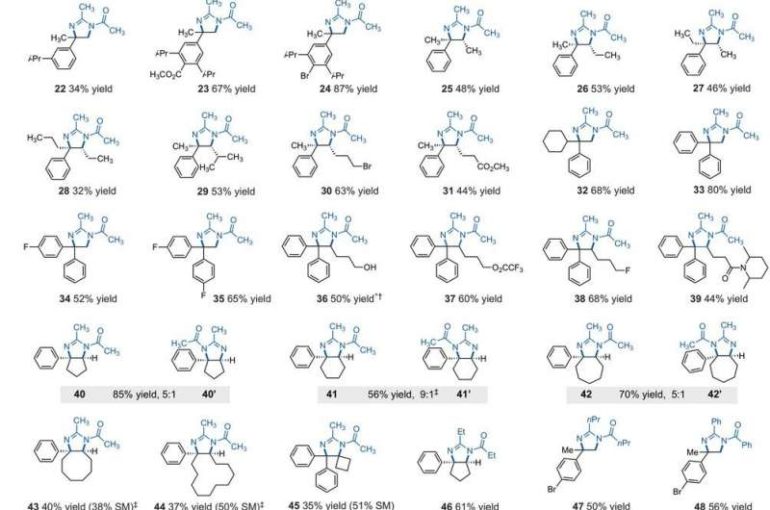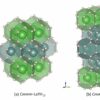In organic chemistry, the conversion of inactivated carbon-hydrogen (C-H) bonds to carbon-nitrogen (C-N) bonds is a highly valued transformation. Scientists can accomplish such reactions at only a single C-H site since the first derivatization can diminish the reactivity of the surrounding C-H bonds. In a new report now published in Science, Tao Shen and Tristan H. Lambert at the department of chemistry and chemical biology, Cornell University, New York, showed that alkylated arenes could undergo vicinal C-H diamination reactions to form 1,2-diamine derivatives using an electrophotocatalytic strategy. During the synthetic process, they used acetonitrile as a solvent and nitrogen source. They catalyzed the reaction using a trisaminocyclopropenium (TAC) ion, which underwent anodic oxidation to furnish a stable radical dication (any cation), while the cathodic reaction reduced protons to molecular hydrogen. When they irradiated the TAC radical dication with a white-light compact fluorescent light, they generated a strongly oxidizing photoexcited intermediate. Based on the electrolyte used, the team obtained either 3,4-dihydroimidazole or aziridine products.
A new synthetic process
Ubiquitous chemical reactions that convert inert carbon-hydrogen (C-H) bonds to valuable carbon-nitrogen (C-N) bonds can greatly accelerate the construction of complex molecules relevant to the biomedical enterprise. Researchers have therefore derived a series of C-H amination reactions, but despite their power and scope, many synthetic campaigns must install numerous C-N linkages. A major challenge to developing chemical such reactions is that heterofunctionality tends to deactivate surrounding bonds toward the typical mechanistic modes of C–H activation. Only a few reaction technologies have thus far therefore accomplished multipotent functions on proximal C-H bonds. Shen et al. described a strategy for potent oxidation chemistry by combining the energy of light and electricity within a single catalyst in a process known as electrophotocatalysis (EPC). During this strategy, the team used electrochemical oxidation of trisaminocyclopropenium (TAC) ion under a relatively mild electrochemical potential and concomitant visible light irradiation to excite the resultant radical cationic intermediate. The photo-excited radical dication was an extremely potent oxidant that demonstrated challenging reactions including oxidative functions of benzene and other electron-poor arenes or the regioselective C-H functionalization of ethers.
The experiment
The team hypothesized the oxidizing power of TAC to also enable other C-H bond activation manifolds. Under the right conditions, the electrophotocatalytic approach could generate carbo-cation intermediates to facilitate Ritter-type functionalization of C-H bonds without an external chemical oxidant. Typically, during Ritter-type reactions generate a carbocation with subsequent trapping by a nitrile to form nitrilium ion intermediates followed by amide products after hydrolysis. The team assumed that the strongly oxidizing, yet selective conditions offered by TAC (trisaminocyclopropenium) EPC (electrophotocatalysis) could allow a sequence of multiple Ritter-type C-H functionalization reactions, where the initially formed acetamide group facilitated a second amination reaction at an adjacent position. If feasible, the method could facilitate the regioselective amination of two C-H bonds simply using visible light, a mild electrochemical potential and a common solvent as the nitrogen source instead of nitrene precursors. Shen et al. reported the realization of the electrophotocatalytic deamination of C-H bonds to furnish dihydroimidazoles or aziridines, depending on the type of electrolyte used during the experiments.
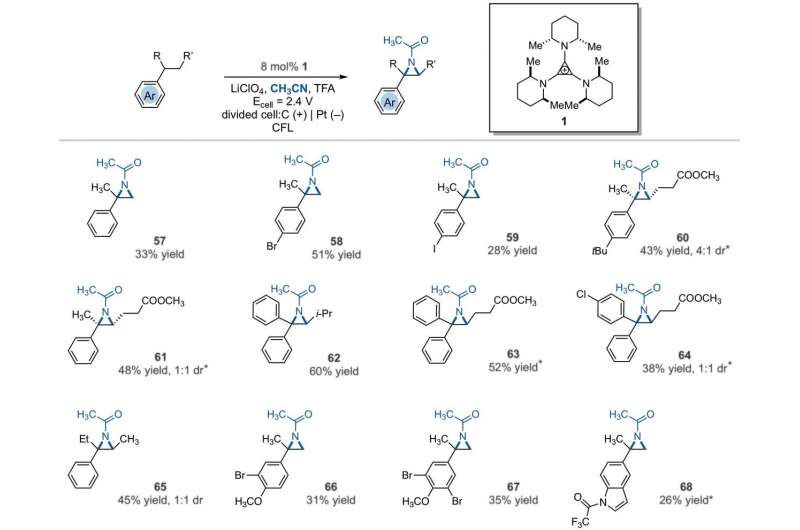
The synthetic products
After extensively screening, the reaction conditions including the cell potential, electrolyte, acid additive and reaction time, Shen et al. identified conditions to assist the efficient conversion of a variety of benzylic hydrocarbons of the corresponding N-acyl-4,5-dihydroimidazole adducts. In the reaction setup, the scientists used visible light irradiation with a white compact fluorescent light of a solution of the substrate containing TAC in a divided electrolytic cell under controlled potential. The team added the TAC catalyst and substrate within the anodic chamber where the C-H deamination chemistry occurred. The resulting redox by-product was effectively traceless. Based on similar conditions, a variety of benzylic hydrocarbons underwent vicinal C-H diamination to form diverse products. In all cases, the researchers noted how the function of methylene carbons occurred in preference to methyl carbons, even when in the presence of a sterically demanding group or electron-withdrawing group. Since the α-α-diaryl amines formed a valuable substructure in biomedically relevant compounds, the team also investigated the transformation on gem-diaryl substrates. They found that the 1,1-diphenyl ethane reacted efficiently to furnish a secondary alkyl benzene compound with 80 percent yield. The compatibility of alcohol, ester, alkyl fluoride and amide substituents allowed the synthesis of more highly functionalized adducts.
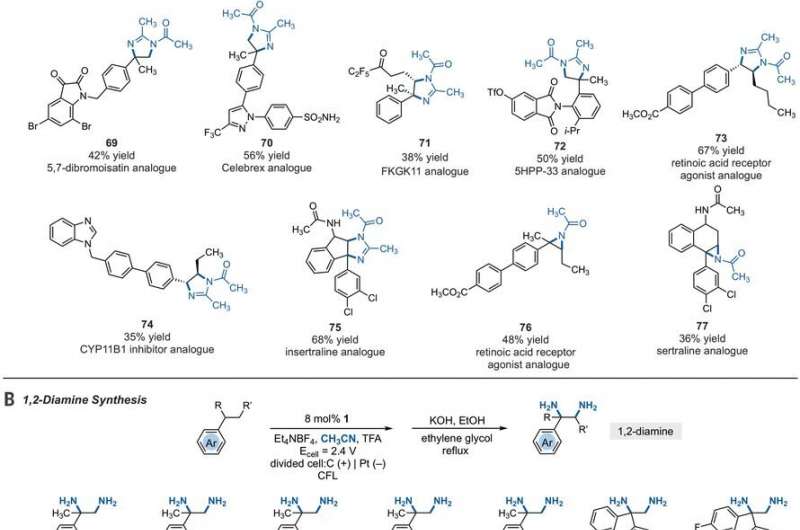
Functionalizing ring systems
The team further studied the potential of this reaction to functionalize ring systems. The reaction of phenyl cyclopentane led to the bicyclic compound in 85 percent yield. The scientists produced six- and seven-membered ring products as regioisomeric mixtures, alongside eight- and 12-membered ring products as single isomers. They improved some of the yields for cyclic substrates by using tetrabutylammonium phosphate (TBAF6) as the electrolyte. In addition to acetonitrile, the researchers used other nitriles to give rise to diaminated products derived from propionitrile, butyl nitrile or benzonitrile as the nitrogen source. The scientists also tested the diamination process using unbranched benzylic substrates. As a result, imine and halogenated derivatives gave rise to aziridines in low to modest yields with nearly equal yields of diaminated products.
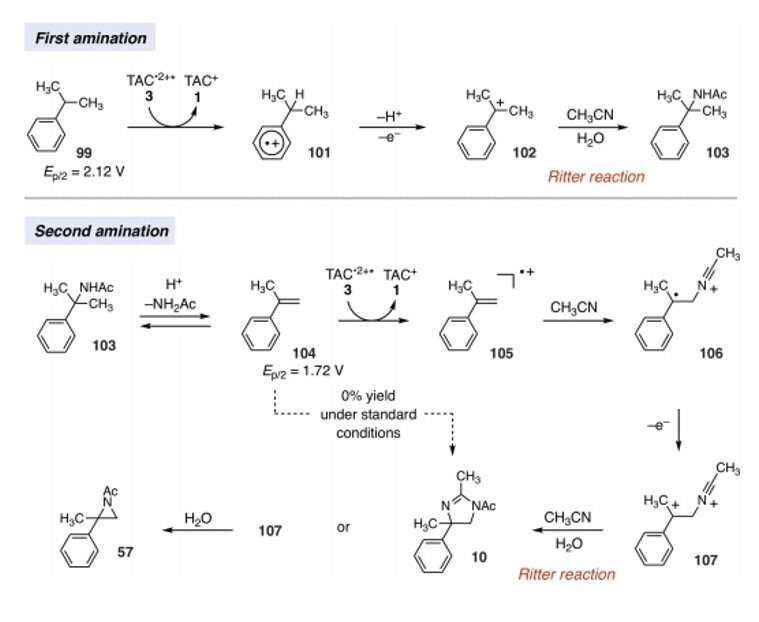
Medicinal compound libraries
Since late-stage C-H functionalization processes offered powerful tools for the diversification of medicinal compound libraries, Shen et al. tested the difunctionalization chemistry on several molecules that are close analogs of known biologically active molecules. The team diaminated a dibromoisatin derivative to produce a bioactive molecule analogue in 42 percent yield. For example, Isatin derivatives have been investigated in the past due to their medicinal properties including antitumor and antiviral activities. The scientists also found that celecoxib analogs could produce 56 percent yield under standard conditions. They then converted an analog of thalidomide with antiproliferative activity into another bioactive analog with 50 percent yield. The team further found how a small modification to the electrophotocatalytic procedure could lead to the isolation of free 1,2-diamines in good yields. Shen et al. believe the mechanisms to have originated with Ritter-type amination of the substrates benzylic C-H bond in a process that accords with known electrochemical Ritter-type reactions. In this way, Tao Shen and Tristan H. Lambert noted the compatibility of deamination with a reasonable diversity of functionality for the practical applications of this reaction. The scientists used the power of combined light and electrical energy to conduct the reactions in the functionality of a single catalyst with advancing synthetic capabilities.
Well connected through amides
More information:
1. Shen T. and Lambert T. Electrophotocatalytic diamination of vicinal C–H bonds, Science, 10.1126/science.abf2798
2. Richter M. F. et al. Predictive compound accumulation rules yield a broad-spectrum antibiotic, Nature, DOI: 10.1038/nature22308
3. Zhang L. et al. Photoelectrocatalytic Arene C-H Amination. Nature Catalysis, 10.1038/s41929-019-0231-9
2021 Science X Network
Citation:
Electrophotocatalytic diamination of vicinal C–H bonds (2021, February 22)
retrieved 22 February 2021
from https://phys.org/news/2021-02-electrophotocatalytic-diamination-vicinal-ch-bonds.html
This document is subject to copyright. Apart from any fair dealing for the purpose of private study or research, no
part may be reproduced without the written permission. The content is provided for information purposes only.
